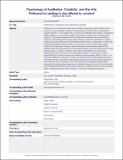Files in this item
Preference for paintings is also affected by curvature
Item metadata
| dc.contributor.author | Ruta, Nicole | |
| dc.contributor.author | Vañó, Javier | |
| dc.contributor.author | Pepperell, Robert | |
| dc.contributor.author | Corradi, Guido B. | |
| dc.contributor.author | Chuquichambi, Erick G. | |
| dc.contributor.author | Rey, Carlos | |
| dc.contributor.author | Munar, Eric | |
| dc.date.accessioned | 2021-05-17T13:30:02Z | |
| dc.date.available | 2021-05-17T13:30:02Z | |
| dc.date.issued | 2021-05-13 | |
| dc.identifier | 273009908 | |
| dc.identifier | 2c57241c-d989-4f68-a5e5-fd26606a9543 | |
| dc.identifier | 85107994044 | |
| dc.identifier | 000733128400001 | |
| dc.identifier.citation | Ruta , N , Vañó , J , Pepperell , R , Corradi , G B , Chuquichambi , E G , Rey , C & Munar , E 2021 , ' Preference for paintings is also affected by curvature ' , Psychology of Aesthetics, Creativity, and the Arts , vol. Online First . https://doi.org/10.1037/aca0000395 | en |
| dc.identifier.issn | 1931-3896 | |
| dc.identifier.other | ORCID: /0000-0001-5300-2913/work/94291765 | |
| dc.identifier.uri | https://hdl.handle.net/10023/23204 | |
| dc.description | The research was funded by the project PSI2016-77327-P of the Spanish government (AEI/ERDF, EU). The Erick G. Chuquichamb acknowledges the pre-doctoral contract FPU18/00365 granted by the Spanish government.Conception, design and performing of the experiments for Study 1: Nicole Ruta and Robert Pepperell. Conception, design and performing of the experiments for Study 2: Enric Munar, Javier Vañó, Erick G. Chuquichambi, Carlos Rey. | en |
| dc.description.abstract | Preference for curvature has been demonstrated using many types of stimuli, but it remains an open question whether curvature plays a relevant role in responses to original artworks. To investigate this, a novel set of paintings was created, consisting of three variations—curved, sharp-angled, and mixed—of the same 16 indeterminate subjects. The present research aimed to differentiate between liking and wanting decisions. We assessed liking both online (Study 1) and in the lab (Study 2, Task 2), using a continuous slider and a dichotomous forced choice, respectively. In both tasks, participants assigned higher ratings to the curved compared to the sharp-angled version of the paintings. Similarly, when participants were explicitly asked if they wanted to take the paintings home, they assigned higher wanting ratings to the curved version (Study 2, Task 3). However, when they were asked to act as a curator selecting the works they wanted for their gallery (Study 2, Task 4) and to make a physical effort to visually consume the painting (implicit wanting; Study 2, Task 1), no significant difference was found. Finally, we found that implicit wanting decisions did not predict liking for paintings, while liking predicted explicit wanting of the artworks in both the home and art contexts. This confirmed that it is possible to differentiate between liking and wanting responses to artistically relevant stimuli. We conclude that this theoretical distinction helps to explain previous conflicting results on the curvature effect, establishing a new line of research in the field of empirical aesthetics. | |
| dc.format.extent | 1791660 | |
| dc.language.iso | eng | |
| dc.relation.ispartof | Psychology of Aesthetics, Creativity, and the Arts | en |
| dc.subject | Art | en |
| dc.subject | Curved | en |
| dc.subject | Preference | en |
| dc.subject | Wanting | en |
| dc.subject | Liking | en |
| dc.subject | BF Psychology | en |
| dc.subject | DAS | en |
| dc.subject.lcc | BF | en |
| dc.title | Preference for paintings is also affected by curvature | en |
| dc.type | Journal article | en |
| dc.contributor.institution | University of St Andrews. School of Divinity | en |
| dc.identifier.doi | https://doi.org/10.1037/aca0000395 | |
| dc.description.status | Peer reviewed | en |
| dc.date.embargoedUntil | 2021-05-13 |
This item appears in the following Collection(s)
Items in the St Andrews Research Repository are protected by copyright, with all rights reserved, unless otherwise indicated.

